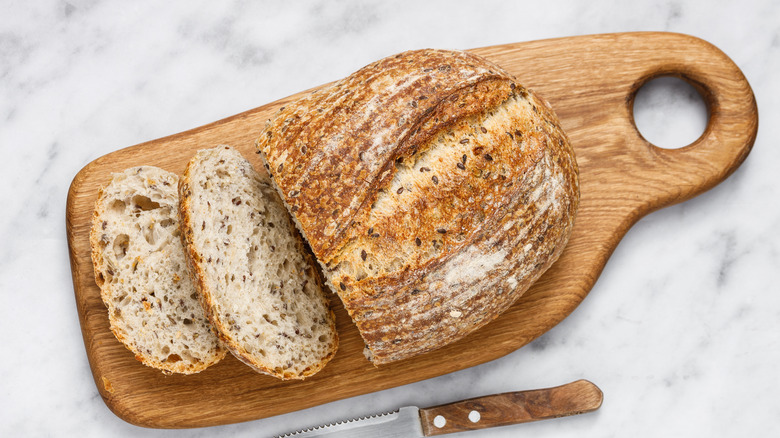Is It Okay To Store Bread On Top Of The Fridge?
As you unpack your bags of groceries, it's important to put the purchases in the right places in order to have an organized kitchen. You place the curry powder in the spice rack and the lettuce in the crisper drawer. But when you get to the full loaf of bread, where does it go? A relatively large item that is also prone to going stale, proper storage is important to enjoy it.
First, it's best to eat a fresh load of bread within a day or two of purchasing or making it, per Food & Wine. When it comes to plastic or paper, paper is the right choice for bread because plastic can help mold to grow faster. An easy place to keep the loaf is on the kitchen counter, but according to Epicurious, it should only be kept there long enough to take a photo for your Instagram account before being properly stored. Keeping a loaf of bread on a counter will leave it vulnerable to going stale. Inside the refrigerator may seem like another fine place to keep that sourdough, but the bread will in fact get stale faster inside the refrigerator despite it being the place where we keep most food that needs to be preserved, per The Perfect Loaf.
The coldness of the fridge will make the bread's starch recrystallize, resulting in a dried-out loaf, according to Southern Living. As bad as the inside of the refrigerator sounds for bread storage, there is a worse location.
Avoid in and on the fridge
Even worse than in the fridge for bread storage is on top of the fridge. That big open space on top of the refrigerator may seem like wasted space, but by keeping bread there, the heat from the refrigerator will cause any bread kept in a plastic bag to grow mold faster, while any bread kept in a paper wrapping will dry out, per Food & Wine. The same goes for other appliances in your kitchen. Don't even think about storing the whole wheat on top of the dishwasher where heat and moisture will also shorten its shelf life. Going with a cool, dry area for storage is the best place for the bread. Think cabinet or deep drawer, explains Food & Wine.
Just remember that at the first sign of mold on your bread, it needs to be thrown into the garbage, advises Martha Stewart. Fuzzy green or black spots as well as a sour odor are indications of mold. Next time you are unpacking your groceries and grab the loaf of ciabatta, think twice before placing it on the refrigerator. Instead, look for a dry, cool place like a bread box, recommends Epicurious, where the bread will stay fresh for the tuna panini you've been craving.

